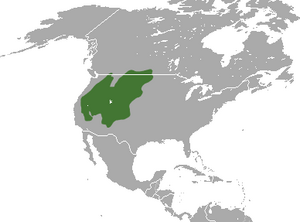Mountain cottontail facts for kids
Quick facts for kids Mountain cottontail |
|
|---|---|
 |
|
| Conservation status | |
| Scientific classification | |
| Genus: |
Sylvilagus
|
| Species: |
nuttallii
|
 |
|
| Mountain cottontail range | |
The mountain cottontail or Nuttall's cottontail (Sylvilagus nuttallii) is a type of mammal. It belongs to the rabbit and hare family, called Leporidae. You can find these rabbits in Canada and the United States.
Contents
What Does a Mountain Cottontail Look Like?
The mountain cottontail is a small rabbit. But it's quite big compared to other rabbits in its group. It has long back legs. Its feet are covered with lots of long hair.
Its ears are short and round at the ends. The inside of its ears also has a lot of hair. This rabbit has light brown fur on its back. It has a special pale brown patch on the back of its head. This patch is called a nape.
Its ears have black tips. Its tail is white-grey, and its belly is white. The brown patch on its head is smaller than the one on a Snowshoe Hare. This helps tell the two different rabbit types apart.
Where Do Mountain Cottontails Live?
This rabbit lives in the middle part of North America. Its home stretches from just above the border between Canada and the United States. It goes south into Arizona and New Mexico.
It also lives from the eastern side of the Rocky Mountains. And it goes west to the eastern side of the Cascade-Sierra Nevada Range.
What Do Mountain Cottontails Eat?
Mountain cottontails mostly eat different kinds of grasses. These include wheatgrasses and needle-and-thread. They also eat Indian ricegrass and cheatgrass brome. Other favorites are bluegrasses and bottlebrush squirreltail.
Depending on where they live, they might also eat shrubs. Some shrubs they enjoy are Big sagebrush, rabbitbrush, and saltbushes. When winter comes and food is harder to find, they might eat more woody plant parts. This includes bark and twigs from trees and bushes.
Reproduction and Life Cycle
Mountain cottontail nests are like a cup-shaped hole. They line the nest with their own fur and dried grass. The female rabbit covers the top of the nest. She uses fur, grass, and small sticks.
In Oregon, about half of the baby rabbits are male and half are female. The breeding season changes depending on the location. It usually runs from February to July. In warmer places, it might last even longer.
On average, a female rabbit has 4 to 6 babies in each litter. The babies grow inside the mother for about 28 to 30 days. A female can get pregnant again very soon after giving birth.
Mountain Cottontail Behavior
Rabbits make two kinds of droppings. One type is dry, which is the normal rabbit poop you might see. The other type is moist. Rabbits usually eat these moist droppings. This is called coprophagy. These moist droppings have many nutrients that the rabbit's body didn't absorb the first time. By eating them again, the rabbit gets all those important nutrients.
Mountain cottontails are not very social animals. They spend most of their time alone. But sometimes, they gather in places where there's a lot of food. They mostly eat at dawn and dusk. They like to feed in clear areas near bushes or other cover. Mountain cottontails are also known to climb juniper trees to find food. More than half the time they are active, they are eating.
The most common social behavior is during mating. Male rabbits usually have a larger home area than females. But they are not territorial, meaning they don't fight over their space.
These rabbits stay active all year long. If a rabbit gets scared, it will run a few meters. Then it will hide and freeze, with its ears standing up. If it's still chased, it will hop away in a curved path. This helps to confuse predators. The main ways they avoid being caught are by being active at dawn and dusk. And by hopping in a curved path when chased.
Many animals hunt mountain cottontails. These include coyotes, bobcats, and lynxes. Other predators are martens, crows, hawks, owls, and rattlesnakes.
Images for kids
See also
 In Spanish: Sylvilagus nuttallii para niños
In Spanish: Sylvilagus nuttallii para niños




